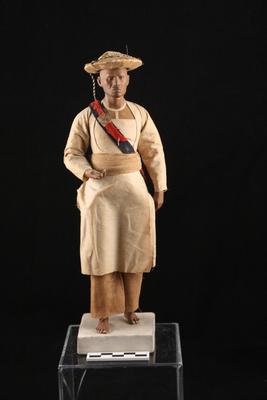E1252: India- Clay Male Figurine
Ethnographic
Identifier:
E1252
Classification Category:
8:Communication Artifacts ➞ Art/Folk Art
Marks/Labels:
None
Materials:
clay ➔ ceramic ➔ earthenware
animal ➔ hair
fabric ➔ cloth ➔ cotton
fabric ➔ cordage
colorant ➔ paint
binding agents ➔ joiners ➔ metal wire ➔ armature
Dimensions:
6.5 cm L
9 cm W
25 cm H
Provenance of Object:
Produced in Calcutta, West Bengal, India in the Krishnanagar (region), created by artisans, each figurine represented a role of the caste system of India. George Winthrop acquired through purchase, and donated to his local museum (now the Ecotarium). The object was then donated to Luther College.
Ethnic Group:
Asian ➞ India ➞ West Bengal ➞ Krishnanagar
Production Date:
Circa 1880
Use/Function:
Categorized as a communication artifact, subcategorized as a documentary artifact, this clay figurine functions as a device to communicate a story or role. In particular, these clay figurines are representative of the caste system that had been present in India.
Source Locality:
The figurines were brought from Calcutta, West Bengal, India to Worcester (around the 1880s) by George Winthrop. The Worcester Ecotarium received the figurines from George Winthrop.
Acquisition Date:
1874 – 1885
Description:
This standing male figurine is believed to be a Krishnanagar figurine. He wears brown pants, a light brown tunic, and a sand colored mesh belt around his waist; extending from his right shoulder to his waist. His exact role in the caste system of India is undetermined, but his slightly extended right arm and cupped right hand indicate that his gesture may have something to do with the role that he represented.

